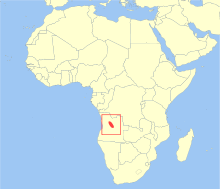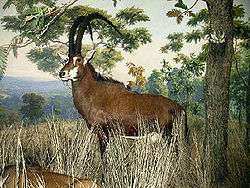Giant sable antelope
| Giant sable antelope | |
|---|---|
| | |
| Scientific classification | |
| Kingdom: | Animalia |
| Phylum: | Chordata |
| Class: | Mammalia |
| Order: | Artiodactyla |
| Family: | Bovidae |
| Subfamily: | Hippotraginae |
| Genus: | Hippotragus |
| Species: | H. niger |
| Subspecies: | H. n. variani |
| Trinomial name | |
| Hippotragus niger variani Thomas, 1916 | |
 | |
| Geographic range | |
The giant sable antelope, (Hippotragus niger variani), also known in Portuguese as the palanca-negra-gigante, is a large, rare subspecies of sable antelope native and endemic to the region between the Cuango and Luando Rivers in Angola.
There was a great degree of uncertainty regarding the number of animals that survived during the Angolan Civil War. In January 2004, a group from the Centro de Estudos e Investigação Científica of the Catholic University of Angola, led by Dr. Pedro vaz Pinto, was able to obtain photographic evidence of one of the remaining herds from a series of trap cameras installed in the Cangandala National Park, south of Malanje.
The giant sable antelope is the national symbol of Angola, and is held in a great regard by its people. This was perhaps one of the reasons the animals survived the long civil war. In African mythology, just like other antelopes, they symbolize vivacity, velocity, beauty and visual sharpness.
The giant sable antelope is evaluated as critically endangered on the IUCN Red List of Threatened Species.
Description

Both sexes have horns, which can reach 1.5 meters in length. Males and females are very similar in appearance until they reach three years of age, when the males become darker and develop majestic horns. The male antelope weighs an average of 238 kg (525 lb) with a height of 116–142 cm (46–56 in). Females weigh 220 kg and are slightly shorter than males. The horns are massive and more curved in males, reaching lengths of 81–165 cm (32–65 in), while females' horns are only 61–102 cm (24–40 in) in length. Coloration in bulls is black, while females and young are chestnut, except in southern populations, where females turn brown-black. Most sable antelopes have white "eyebrows", their rostra are sectioned into cheek stripes, and their bellies and rump patches are white. Young under two months old typically are light brown and have slight markings.
Ecology and behavior
Like all antelopes, giant sables are shy by nature, but they can also be very aggressive. The males can be especially dangerous when hurt, attacked, or approached. In fights, males avoid some serious injuries by kneeling down on their front legs, and engage in horn-wrestling fights. Fatalities from these fights are rare.
Juveniles are hunted by leopards and hyenas, while adults are only threatened by lions and crocodiles.[2] When startled, the antelope normally run for only a short distance before slowing and looking back; however, when they are pursued, they can run at speeds up to 35 mph for a considerable distance.[2]
Habitat
The giant sable antelope lives in forests near water, where leaves and tree sprouts are always juicy and abundant. It is an endangered species; it is protected in natural parks, and hunting it is forbidden. Typically, sable antelopes are specialized browsers feeding on foliage and herbs, especially those growing on termite mounds. One of the reasons for the decline in antelope numbers could be the animals' very specific feeding patterns. Typically, they will feed on tree leaves, which make up to 90% of their diets, at heights of 40–140 mm (1.6–5.5 in) from the ground, taking only the leaf.
Relationship with humans
The giant sable antelope is a national symbol of Angola and is portrayed on numerous stamps, banknotes, and even passports of the nation.[2] The Angola national football team is fondly known as the Palancas Negras in honor of the antelope.[2]
References
- ↑ IUCN SSC Antelope Specialist Group (2008). "Hippotragus niger variani". IUCN Red List of Threatened Species. Version 2008. International Union for Conservation of Nature. Retrieved 29 March 2009. Database entry includes a brief justification of why this species is of critically endangered.
- 1 2 3 4 Ellis, Richard (2004). No Turning Back: The Life and Death of Animal Species. New York: Harper Perennial. p. 139. ISBN 0-06-055804-0.
- Walker, John Frederick. A Certain Curve of Horn: The Hundred-Year Quest for the Giant Sable Antelope of Angola. Atlantic Monthly Press. 2002.
- Cabral, C. & Verissimo, L. (2005) - The Ungulate Fauna of Angola, systematic list, distribution maps, database report. Instituto de Investigação Científica Tropical, Estudos Ensaios e Documentos, 163, Lisboa
- Mellon, James African Hunter Safari Bress (185)
External links
- ANGOLA: Rare sable antelope survives the war
- Kissama National Park: The Giant Sable of Angola
- BBC News: Search on for Giant Antelope
- Angola Press: Government Partners Sign Memorandum on Sable Antelope Protection
- Dr. Pedro Vaz Pinto's blog on attempts to revive the giant sable herd in Angola's Cangandala National Park
